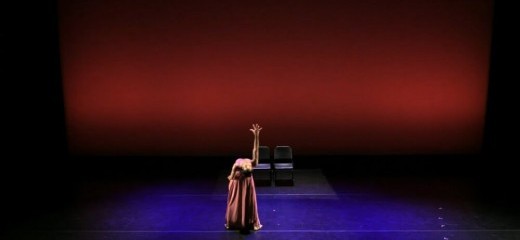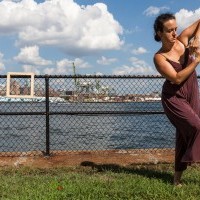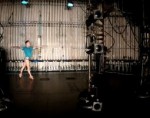
Philadanco: Meeting the Moment
by Christina Catanese
A dark-skinned man lay on his side, tensed, wrists crossed behind his back, hands in fists. Seeing this through my computer screen during Philadanco’s livestream performance at the Annenberg stuck with me, in an evening program filled with brilliantly danced performances of painfully timely themes.
The poignant image came during dancer Joe González’s performance of an excerpt from A Movement for Five, inspired by the story of the Central Park Five. A group of five Black and Brown teenage boys were wrongfully arrested and convicted of charges related to the rape and assault of a white female jogger in 1989, then exonerated in 2002 after serving out their sentences. The case is widely seen as emblematic of a justice system that consistently fails to uphold justice for people of color, and seeing the Five’s story danced in our shaken city this week cut close. Performing movement by Dawn Marie Bazemore, González struggled to get his footing, percussively softening into repetitive loops, caught in the boundaries of narrowing patches of light on stage. I sensed the will to speak up but the frustration at not being heard, a visceral striving for what is right against all odds. After this hauntingly beautiful performance, I yearned to see the rest of the larger work.
Another angle on civil rights on the program was an excerpt from Rosa, a tribute to Rosa Parks, danced by Janine Beckles. The lights came up on two chairs at center stage; Beckles walked up to them and looked at them pointedly, arms akimbo, as the voice of Roberta Flack swelled. The abundant fabric of her long, dusty pink dress flowed around during the many turns and extensions of Billy Wilson’s choreography—though she made the movement look easy, she more than earned the seat she powerfully occupied to conclude the dance. This, of course, explicitly referenced Parks’ refusal to move to the back of the bus. But before giving us the satisfaction of this image, the solo elongated the moment of the decision to hold her seat, expounding on the challenges, pride, defiance, even weariness that informed this historic choice.
Dancing together in With-Held, Beckles and González entered wearingblack face masks, walking by each other across the stage without acknowledgement, clearly grounding the work in pandemic times. The two sections of the work explored “how to hold on to someone while being withheld from them,” per the program notes. The first section of the piece was tender and poignant with the energetic connection of the dancers spanning the distance between them, after they took their masks off with a sense of delicious liberation. An abrupt shift from the soaring violin and piano came with dissonant, intense, mechanistic thrumming. The choreography (by the dancers) mixed suspended lyrical lines and turns with now-familiar gestures—vigorous hand scrubbing, going in for a handshake and pulling away, reaching for an embrace from a distance. Ultimately, they put their masks back on and exited the stage separately. The piece felt unresolved, as our times and the pandemic currently do.
Finally, Super 8! took us out of suffering and into Black joy. Playful and sultry, Beckles and González seemed to be egging each other on. They did partner work and exchanged solos, seemingly one-upping each other on the extent to which they were feeling themselves and the music. This work gave these exquisite dancers a chance to show off their skill and have fun—they appeared genuinely thrilled to be dancing live on stage, and confirmed as much in the post-show Q&A.
Joining in the Q&A was the company’s legendary founder Joan Myers Brown, who this month stepped out of her role as executive and artistic director at age 88. After taking an important question from a 9-year-old digital viewer (“Can you do backflips? Can you do any ninja moves?”), Myers Brown and the dancers reflected on the past, present, and future of Philadanco, and the challenges of being Black in America, and in the arts. The company’s 50th anniversary celebrations this year (and the dancers’ lives) did not unfold at all as planned.
This evening’s performance came not even a week after the police murder of Walter Wallace, Jr. (about 30 blocks west on Locust Street from the theater). Philadelphia’s storied and predominantly African-American dance company presented an evening of stunning solos and duets that touched on systemic racism, civil rights, and connection during the pandemic, while also bringing us together to celebrate beauty and endurance. Philadanco is a balm for our tender and precarious times, and a reminder of how deep resilience runs.
Philadanco, Annenberg Center online, October 29.
By Christina Catanese
November 5, 2020







